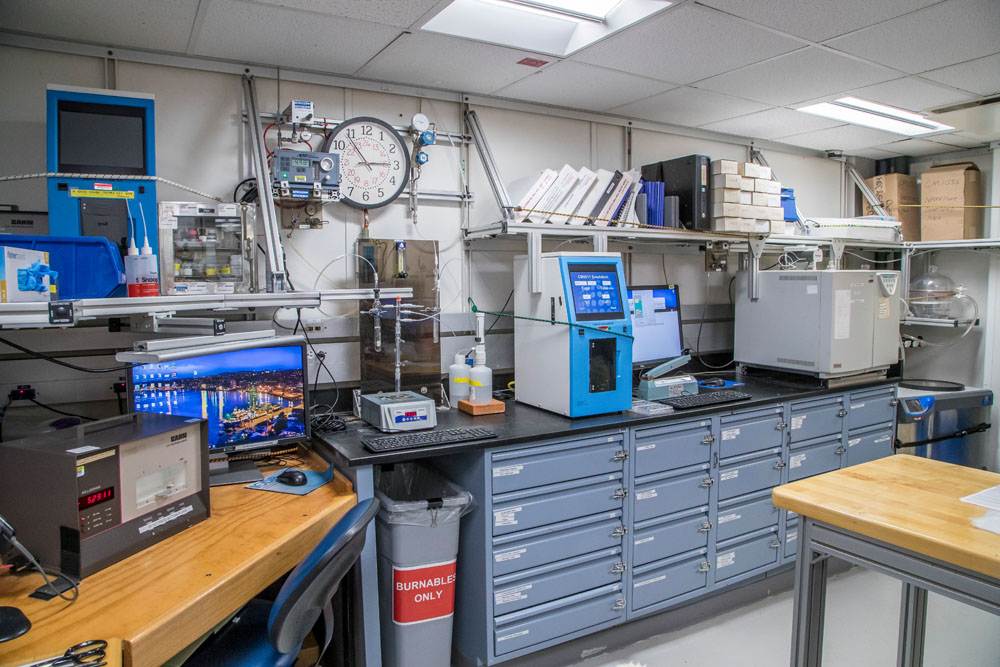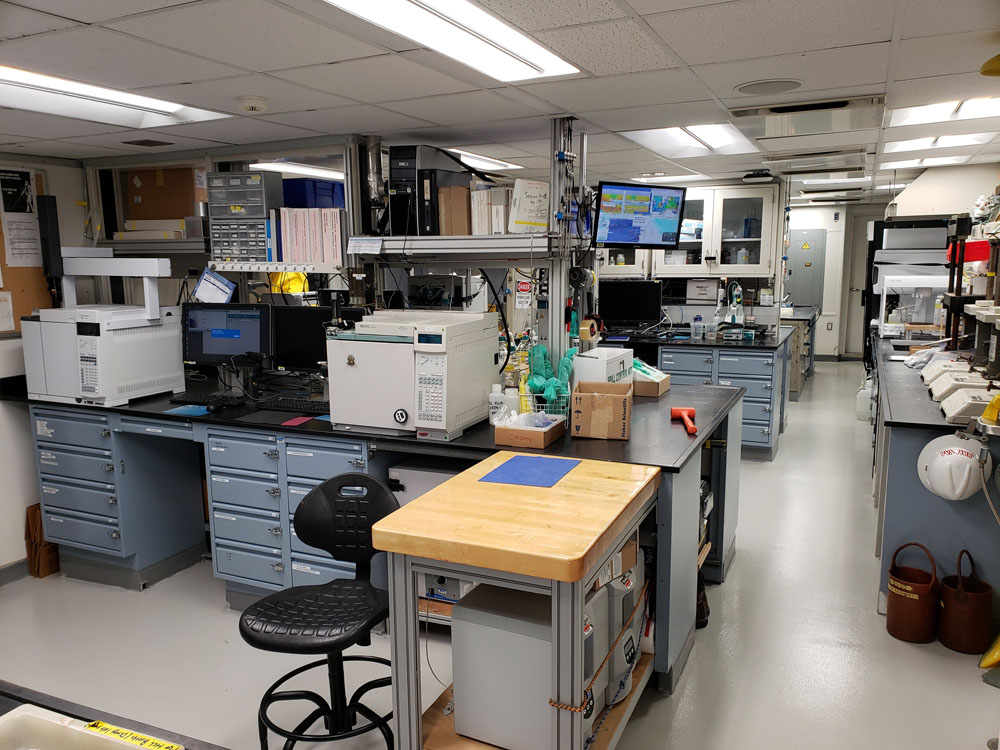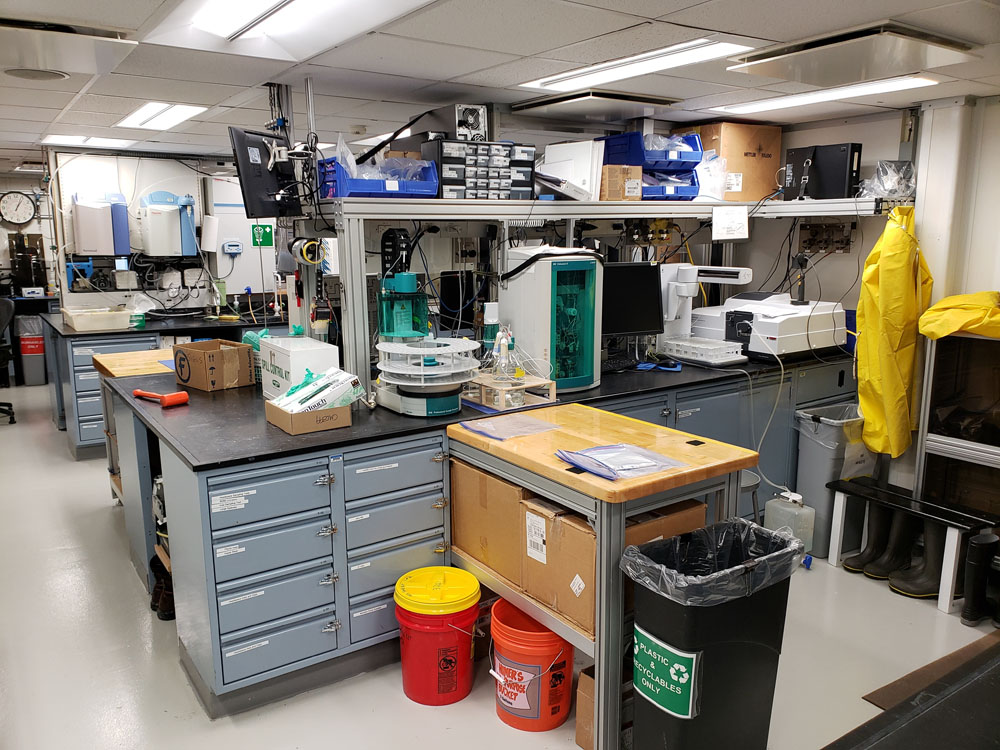Scientific Ocean Drilling Vessel
Chemistry Laboratory
Function
The Chemistry laboratory is used by shipboard scientists to conduct organic and inorganic geochemical analyses. A primary responsibility of the organic geochemists is to provide hydrocarbon data for safety and environmental concerns. In addition, instruments are available for determining the source, amount, and maturity of organic matter; carbonate content; and total carbon, nitrogen, and sulfur.
Inorganic geochemists have a wide array of analytical instruments at their disposal for determination of a large range of interstitial water constituents that typically include pH, alkalinity, chloride, calcium, magnesium, sulfate, potassium, strontium, sodium, manganese, phosphate, silica, and ammonium. Two Laboratory specialists provide dedicated, 24-hour technical support. More...
Instruments
- Two Agilent 7890 gas chromatographs with flame ionization detector (FID) and thermal conductivity detector (TCD)
- Metrohm 794 SM Titrino autotitrators
- Cahn Model 29 or 31 Microbalance (samples <100 mg)
- Carver hydraulic presses
- UIC CM5015 Coulometer
- Metrohm Ion Chromatograph
- Agilent 5110 SVDV ICP-AES
- Weatherford Instruments Source Rock (SR) Analyzer
- Mettler-Toledo XS204 dual-balance system (samples >100 mg to 200 g)
- Agilent Cary 100 UV-Visible Spectrophotometer with sipper option
- Thermo Electron Flash EA 1112 Element Analyzer (CHNS)
- Chloride autotitrator
- Please note that proprietary manuals may be available upon request and subject to limited use
See Laboratory Manuals, Guides, and Resources for Chemistry.
Organic Geochemistry
Safety Monitoring
Organic geochemists perform a vital function on the ship by providing routine safety monitoring for hydrocarbon gases. Typically, a ~5 cm3 sediment headspace sample is collected at a frequency of one/core, heated, and the evolved gases are analyzed with a gas chromatograph (GC). When gas pockets are detected in the core liner, a vacutainer sample can be taken to sample the gas directly. Two Agilent GCs are equipped with both FID and TCD detectors to measure hydrocarbons from methane to heptane. In addition, nonhydrocarbon gases such as hydrogen sulfide, oxygen, nitrogen, carbon dioxide, and carbon monoxide can be analyzed at the same time as hydrocarbon gases.
Organic Matter
A Weatherford Instruments Source Rock Analyzer (SRA) uses a pyrolysis technique to identify the type and maturity of organic matter.
Elemental Analysis
Sediment samples can also be analyzed for total carbon, nitrogen, sulfur, and carbonate carbon. The total organic carbon of the sediment can be determined by calculating the difference between total carbon and carbonate carbon. Carbonate carbon is measured by coulometric titration using a Coulometrics CM5015 analyzer. A Thermo Electron Flash EA 1112 Element Analyzer is used to determine total carbon, nitrogen, and sulfur.
Inorganic Geochemistry
Shipboard interstitial (pore) water analyses are typically performed on waters extracted from 5–10 cm3 whole-round sections. The routine shipboard interstitial water sampling program calls for one whole-round sample to be taken per core for the first six cores, and one sample every third core thereafter. Pore water is extracted from core samples by applying pressures up to 40,000 lb (~4150 psi) with a Carver hydraulic press. Immediately after extraction and filtration, aliquots are analyzed for salinity using a hand-held particular refractometer, and for pH and alkalinity using Metrohm autotitrators.
Chloride is also determined by titration. A variety of nutrients and other pore water constituents (e.g., ammonium, silica, phosphate, nitrate, and nitrite) can be determined using a Cary UV-VIS spectrometer. Numerous cations and anions can be analyzed using a Metrohm Ion Chromatograph (e.g., calcium, magnesium, sulfate). A variety of other elements can be determined by inductively coupled plasma–atomic emission spectrometry on an Agilent 5110 Single View/Dual View ICP-AES. A typical suite of elements determined for interstitial water samples includes Sr, Li, Fe, Mn, B, and Ba. In addition, hard rock samples can be analyzed for all major and minor elements.
See all chemicals used in shipboard labs.


